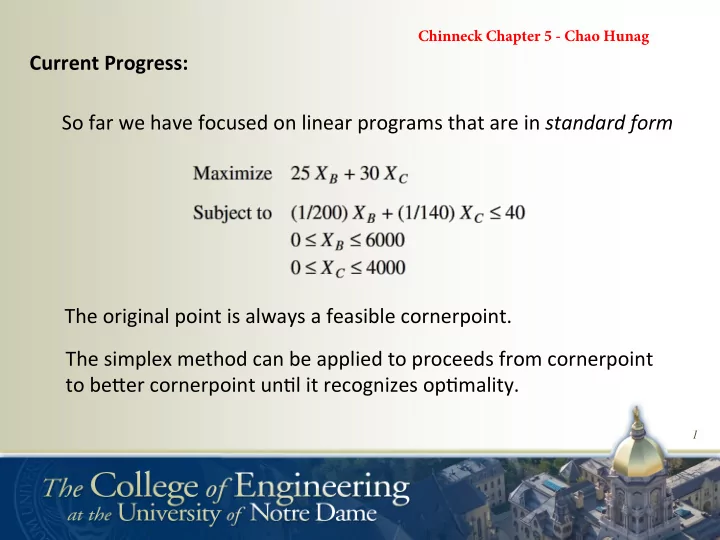

Chinneck Chapter 5 - Chao Hunag Current ¡Progress: So ¡far ¡we ¡have ¡focused ¡on ¡linear ¡programs ¡that ¡are ¡in ¡standard ¡form The ¡original ¡point ¡is ¡always ¡a ¡feasible ¡cornerpoint. ¡ The ¡simplex ¡method ¡can ¡be ¡applied ¡to ¡proceeds ¡from ¡cornerpoint ¡ to ¡be;er ¡cornerpoint ¡un<l ¡it ¡recognizes ¡op<mality. 1 1
In ¡Prac0ce: Not ¡all ¡forms ¡of ¡LPs ¡are ¡just ¡standard ¡form ¡LPs Transforma0on: Mul<ply ¡by ¡-‑1 Mul<ply ¡the ¡op<mum ¡objec<ve ¡func<on ¡value ¡by ¡-‑1 ¡to ¡recover ¡the ¡ minimum ¡value ¡of ¡the ¡original ¡minimiza<on ¡objec<ve ¡func<on 2
Equality ¡Constraints: Acme ¡Bicycle ¡Company ¡Problem Equality ¡Constraint We ¡add ¡a ¡dimension ¡to ¡the ¡mathema<cal ¡representa<on ¡of ¡the ¡original ¡problem We ¡add ¡a ¡non-‑nega4ve ¡ar4ficial ¡variable ¡to ¡any ¡equality ¡constraints 3
Solu0on: Add ¡slack ¡variables ¡for ¡the ¡constraints We ¡add ¡one ¡slack ¡variable ¡for ¡the ¡first ¡constraint We ¡add ¡another ¡slack ¡variable ¡for ¡the ¡second ¡constraint 4
Solu0on: Add ¡slack ¡variables ¡for ¡the ¡constraints The ¡third ¡constraint ¡will ¡involve ¡x1 ¡and ¡x2, ¡and ¡we ¡may ¡not ¡be ¡able ¡to ¡directly ¡see ¡how ¡ to ¡set ¡those ¡two ¡values ¡such ¡that ¡all ¡of ¡the ¡constraints ¡are ¡sa<sfied ¡simultaneously. ¡ We ¡cannot ¡add ¡the ¡third ¡slack ¡variable ¡for ¡the ¡third ¡constraint, ¡since ¡it ¡is ¡already ¡in ¡ equality ¡format. ¡Therefore, ¡we ¡add ¡a ¡nonnega<ve ¡ ar4ficial ¡variable ¡ to ¡the ¡equality ¡ constraints. 5
Phase ¡1 ¡LP Phase ¡ 1 : ¡ solve ¡ an ¡ LP ¡ whose ¡ objec<ve ¡ is ¡ to ¡ minimize ¡ the ¡ value ¡ of ¡ any ¡ ar<ficial ¡variable ¡in ¡the ¡model. ¡For ¡the ¡case ¡a1, ¡if ¡you ¡can ¡drive ¡all ¡of ¡the ¡ ar<ficial ¡variables ¡to ¡zeros, ¡then ¡you ¡will ¡be ¡at ¡a ¡feasible ¡cornerpoint ¡of ¡the ¡ original ¡problem. Phase ¡2 : ¡star<ng ¡at ¡the ¡feasible ¡cornerpoint ¡found ¡during ¡phase ¡1, ¡switch ¡ over ¡ to ¡ the ¡ original ¡ objec<ve ¡ func<on ¡ and ¡ con<nue ¡ itera<ng ¡ un<l ¡ the ¡ op<mum ¡point ¡is ¡found. 6
Phase ¡1 Solve ¡an ¡LP ¡whose ¡objec<ve ¡is ¡to ¡minimize ¡the ¡value ¡of ¡any ¡ar<ficial ¡variables W ¡is ¡defined ¡as ¡the ¡sum ¡of ¡the ¡constraint ¡viola<ons Mul<ply ¡by ¡-‑1 7
Ini0al ¡Tableau This ¡tableau ¡has ¡two ¡objec<ve ¡func<ons: ¡W ¡for ¡phase ¡1, ¡which ¡seeks ¡to ¡ minimize ¡the ¡sum ¡of ¡the ¡ar<ficial ¡variables ¡(i.e., ¡a1) Z ¡for ¡phase ¡2 ¡which ¡represents ¡the ¡original ¡objec<ve. 8
We ¡need ¡to ¡eliminate ¡the ¡coefficient ¡in ¡the ¡phase ¡1 ¡(W) ¡objec<ve ¡func<on ¡row We ¡subtract ¡each ¡row ¡containing ¡an ¡ar<ficial ¡variable ¡from ¡the ¡phase ¡1 ¡ objec<ve ¡func<on ¡now. ¡We ¡subtract ¡equa<on ¡3 ¡from ¡equa<on ¡ph1. 9
10
11
12
13
Recognizing ¡Infeasible ¡LP If ¡there ¡is ¡no ¡feasible ¡solu<on, ¡it ¡is ¡difficult ¡to ¡construct ¡linear ¡programs x ≤ 8 x ≥ 10 & If ¡the ¡phase ¡1 ¡LP ¡terminates , W ¡is ¡s<ll ¡posi<ve, ¡then ¡not ¡all ¡of ¡ the ¡constraint ¡viola<ons ¡have ¡been ¡eliminated . This ¡means ¡the ¡ LP ¡is ¡infeasible. One ¡ or ¡ more ¡ of ¡ the ¡ ar<ficial ¡ variables ¡ could ¡ not ¡ be ¡ forced ¡ to ¡ zero ¡ and ¡ for ¡ feasibility , all ¡ of ¡ the ¡ ar<ficial ¡ variables ¡ must ¡ be ¡ forced ¡to ¡zero. Tools ¡( IIS ) 14
The ¡Big-‑M ¡Method It ¡is ¡an ¡alterna<ve ¡to ¡the ¡two-‑phase ¡method ¡that ¡we ¡described ¡above Phase ¡2 ¡Objec<ve ¡Func<on ¡ Phase ¡1 ¡Objec<ve ¡Func<on ¡ Single ¡Objec<ve ¡Func<on ¡ If ¡M ¡is ¡a ¡large ¡posi<ve ¡number ¡then ¡a ¡straighXorward ¡solu<on ¡of ¡the ¡problem ¡will ¡drive ¡ a1 ¡to ¡zero, ¡because ¡it ¡has ¡such ¡a ¡reducing ¡effect ¡on ¡Z. 15
Greater-‑than-‑or-‑Equal ¡Constraints ≥ The ¡solu<on ¡to ¡this ¡problem ¡is ¡to ¡convert ¡ To ¡an ¡equality ¡constraint ¡by ¡including ¡a ¡surplus ¡variable ¡ ¡ ¡ 16
A ¡surplus ¡variable ¡cannot ¡be ¡used ¡as ¡the ¡basic ¡variable ¡for ¡the ¡constraint ¡it ¡ ¡ appears ¡in ¡because ¡its ¡coefficient ¡is ¡-‑1, ¡and ¡we ¡need ¡+1 ¡for ¡the ¡coefficients ¡ ¡ of ¡basic ¡variables 17
Thank ¡You! ¡ 18
Recommend
More recommend